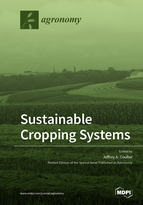Sustainable Cropping Systems
A special issue of Agronomy (ISSN 2073-4395). This special issue belongs to the section "Innovative Cropping Systems".
Deadline for manuscript submissions: closed (31 October 2019) | Viewed by 82219
Special Issue Editor
Special Issue Information
Dear Colleagues,
Global crop production must increase substantially to meet the needs of a rapidly growing population. This is constrained by the availability of nutrients, water, land, and energy. It is further challenged by variability and change in climate and pests, and soil degradation. There is also an urgent need to reduce negative environmental impacts from crop production. Collectively, these issues represent one of the greatest challenges of the 21st century. Sustainable cropping systems based on ecological principles are the core for integrated approaches to solve this grand challenge.
This special issue is intended to provide an international base for revealing the underlying mechanisms of sustainable cropping systems to drive agronomic innovations. Reviews and original research reporting novel scientific findings on improvement of cropping systems relating to crop yields and their resilience to biotic and abiotic stressors, resource use efficiency, environmental impact, sustainability, and ecosystem services are welcomed.
Prof. Dr. Jeffrey A. Coulter
Guest Editor
Manuscript Submission Information
Manuscripts should be submitted online at www.mdpi.com by registering and logging in to this website. Once you are registered, click here to go to the submission form. Manuscripts can be submitted until the deadline. All submissions that pass pre-check are peer-reviewed. Accepted papers will be published continuously in the journal (as soon as accepted) and will be listed together on the special issue website. Research articles, review articles as well as short communications are invited. For planned papers, a title and short abstract (about 100 words) can be sent to the Editorial Office for announcement on this website.
Submitted manuscripts should not have been published previously, nor be under consideration for publication elsewhere (except conference proceedings papers). All manuscripts are thoroughly refereed through a single-blind peer-review process. A guide for authors and other relevant information for submission of manuscripts is available on the Instructions for Authors page. Agronomy is an international peer-reviewed open access monthly journal published by MDPI.
Please visit the Instructions for Authors page before submitting a manuscript. The Article Processing Charge (APC) for publication in this open access journal is 2600 CHF (Swiss Francs). Submitted papers should be well formatted and use good English. Authors may use MDPI's English editing service prior to publication or during author revisions.
Keywords
- Cropping systems
- Sustainable crop production
- Agroecology
- Nutrient use efficiency
- Water use efficiency
- Environmental quality
- Ecosystem services






